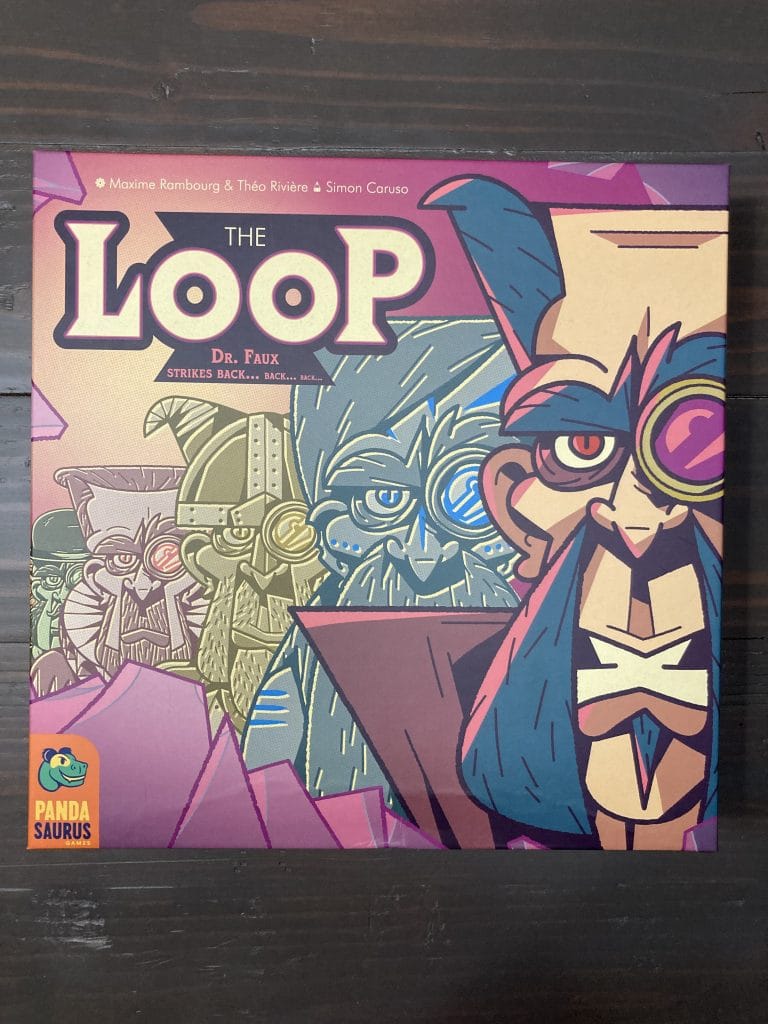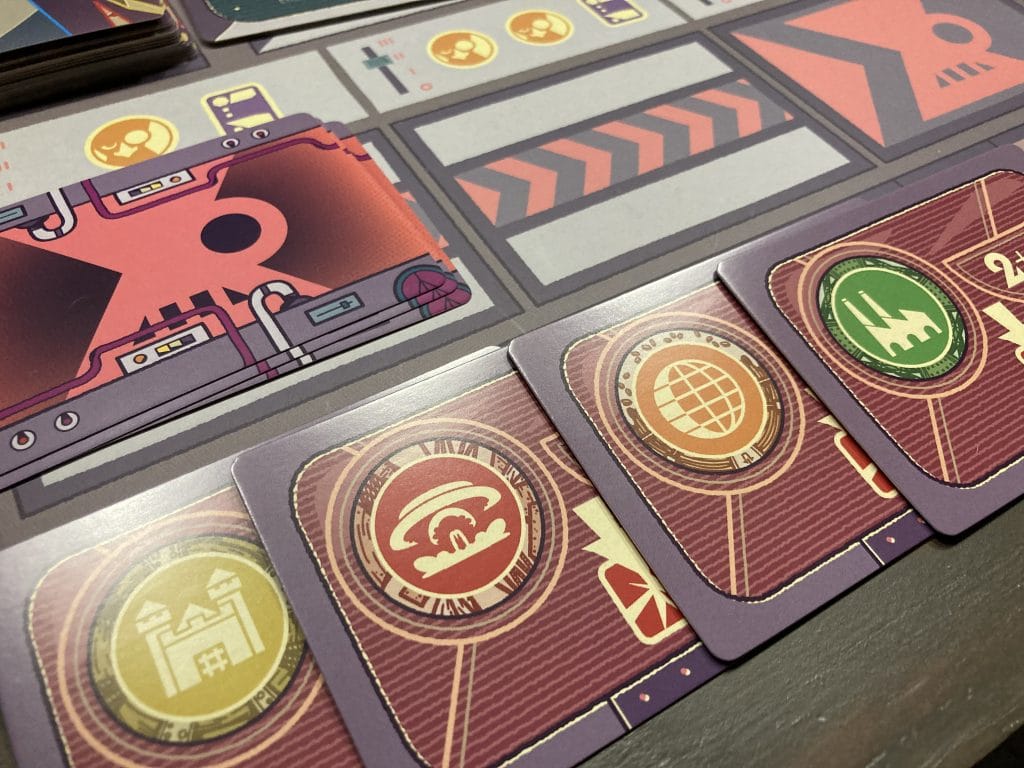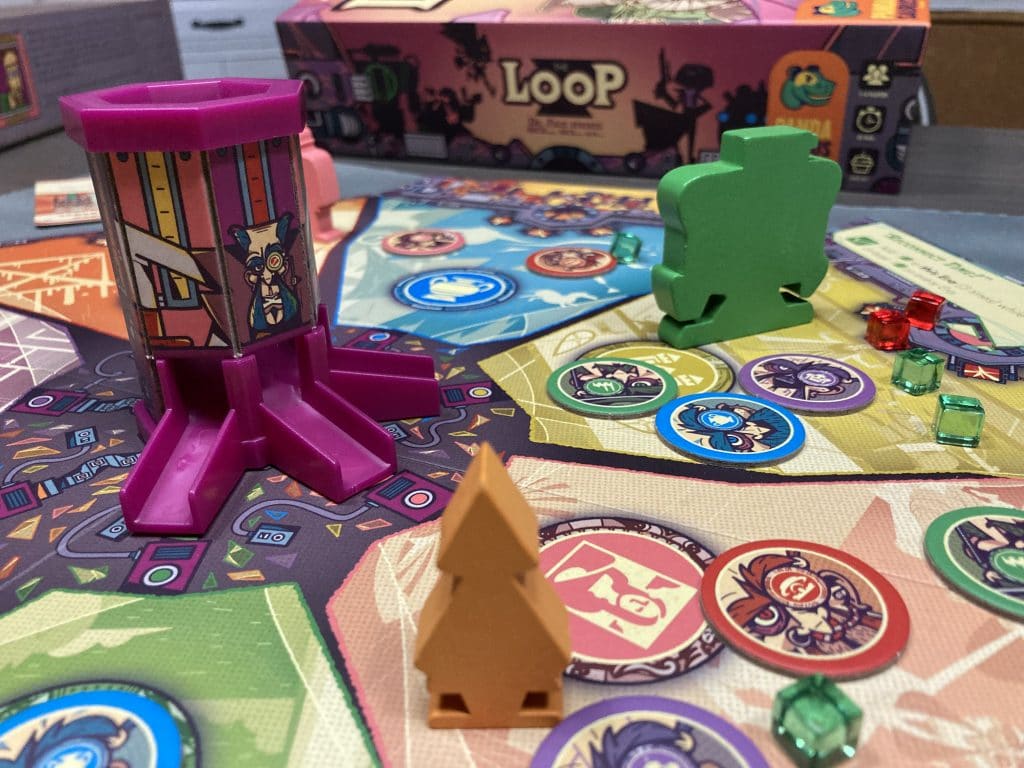Instead of watching the original Space Jam, now that I’ve put that earworm back into my mind, I think I’ll play another round of The LOOP! Designed by Maxime Rambourg and Théo Rivière, The LOOP enlists the help of the players as Time Agents trying to thwart the dastardly plans of Dr. Faux as he ravages across the eras of history.
I’ll get into it with more detail later on, but the game’s namesake comes from the LOOP mechanic that players need to utilize to maximize their efforts against the doctor. What, you didn’t think Time Agents would have access to such advanced and powerful mechanisms? If Loki can have it, so can we!
Let’s take a look at this time-traveling, era-hopping game published by Pandasaurus Games!
The LOOP Gameplay
The contents of the rulebook for The LOOP are written in a very comical and tongue-in-cheek fashion that reads like an Employee Orientation straight out of The Umbrella Academy. We’re Time Agents and we’ve been called into action!
Each turn, players will advance Faux’s plans, traverse through time-space to thwart his clones, and acquire artifacts. The goal in the base game is to complete four missions before time is upended by four Vortexes. Other variants of the game introduce other mechanics that twist and warp The LOOP to keep the challenge high.
Players take control of Time Agents, each with their own powers and abilities that will make the fight against Dr. Faux more manageable. They have a huge impact on the game, and trying to win with different combinations is a worthwhile endeavor to see if you’ve truly mastered time or not.
At the beginning of every turn, Dr. Faux creates some clones on the various Eras of the board. Then, a random Era is drawn, which will turn the Machine to be centralized there. The Machine is a nifty little ‘dice-tower’ component that will cause Rift cubes to go into Faux’s Era or one of the two adjacent Eras. More Rift cubes are dropped depending on the number of Clones present in that Era, so Agents need to be constantly zipping around the board to get rid of them.
If too many Rift Cubes are on an Era, a Vortex occurs. This means that Agents can no longer complete the Mission associated with that Era. If a fourth Vortex is triggered, the game ends and Dr. Faux reigns supreme.
After the chaos of the Faux turn, it’s time for the Agent to shine. Each Agent takes their cards and plays them in whatever order they prefer. Some move the Agent around the board, others eradicate clones, and some create Energy cubes which power movement and the beloved LOOP effects. Cards that are played get exhausted (read: turned sideways), denoting that they’ve been depleted of power for this turn.
However, players can spend Energy cubes to recharge their cards and continue their turn! This is such an awesome mechanic because it allows the players to set-up complex turns to turn the tables on Dr. Faux in a big way. Watch out, however, because each time you LOOP in a turn causes the subsequent LOOP to cost more and more Energy. Time is fragile, y’all.
There’s a blend of deck-building that takes place as you gather more Artifacts for your deck over the course of the game. These are generally even more powerful than the base deck of cards, but you’re not going to see them many times during play. I’d call LOOP a lite-deckbuilder, since you really aren’t cycling through your deck and pruning its contents.
As the game nears the end, things increase in difficulty. Suddenly you’re dealing with more clones using the same number of actions. It can get really brutal, even in the base game, but I really enjoyed working with what I was given to try and produce the best possible outcome.
Staking Our C.L.A.I.M. on The LOOP !
![The Loop Icon]() Components
Components
Now the novel component in The LOOP is the Machine. It stands at the center of the board, practically taunting the table to guess where it’s going to turn next. And, I might add, it’s cleverly made of cardboard and two plastic pieces that is a minor feat in engineering to begin with.
Every Time Agent has its own BIG wooden meeple, custom-shaped to match the Agent. It’s super easy to distinguish the Agents from each other, both by shape and also by color, even from the opposite side of the table. Overall, the game has really great table presence and does its job to draw me in as a passerby.
The other worthwhile components are the cloth bag to store the Clones, and the semi-transparent Rift and Energy cubes. There is a lot happening on the board, and so it’s super important that players can manage the situation with Clones, cubes, and characters all vying for attention. I’m happy to report that the game feels like organized clutter; despite there being a lot of pieces grouped together, its intuitive to the mechanics of the game.
I know that seemed like a knock, but it really wasn’t. To put it differently, there is plenty of differentiation between the components that makes them stand out on their own merits and design.
![The Loop Icon]() Luck
Luck
You can go into games of The LOOP with a general strategy, but prepare for that to be instantly changed after turn one. During every turn, players are confronted with a myriad of choices. Should we spend our efforts working towards the Missions? Or would it be better to get rid of the Clones? Or should I build up the Energy cubes to give us a handful of explosive turns all in a row?
The strategy of the game is 100% focused on being fluid to the board-state. You can’t get too comfortable with how things are going in the moment, because every time those Rift cubes dropped you will find yourself in a brand new situation. Certain Agents are better at doing certain things, so generally speaking you should be leveraging those abilities to align with their strengths.
Sometimes it’s even okay to completely abandon an Era momentarily. After all, you only need to complete four Missions to beat the base game, so you are able to let some of the Eras slide. This would be the moment where I’d say something quippy about needing to break a few eggs to make an omelet, but I don’t know how the eggs will keep when traveling between Eras.
![The Loop Icon]() Aesthetics
Aesthetics
The design style of The LOOP is impressive. Simon Caruso did a really good job of translating the idea of a Time Agency by utilizing a combination of retro futurism and contemporary aesthetic. The general color palette evokes that imagery of something sort of antique, but also edgy and powerful. I dig it.
The whole thing kind of gives me a Saturday morning cartoons kind of vibe, like I would wake up and watch these Time Agents with lots of bright pops of color and anime-style intros. And whenever we talk about time travel, people always seem to lean heavily into the same general concepts of combining old tech with flashy bits. The Loki show did it, as did the Umbrella Academy, and countless others. It’s a style that I really enjoy and appreciate, like people in the 1950s imagining the future while still being semi-incapable of imagining technology looking anything different than what they currently had.
If I had one qualm about the aesthetics of The LOOP, it would be that there are a lot of different colors going on. Each Era has its own color, which is used on the board and the Clones. The Agents, then, also have their own colors which are similar to the colors used elsewhere in the game. Visually it can be a lot to manage at times. Luckily, there is plenty of iconography to help guide you through it all.
![The Loop Icon]() Interest
Interest
The LOOP is a fun game that constantly throws chaos right at your face. Bad stuff WILL happen, and the game is more about adapting to the ever-changing conditions and managing your resources in the most optimal way possible.
Fans of programming games, like RoboRally, will find a nice joy in The LOOP. Usually there is a set ordering pattern that makes the most sense, if the players are able to puzzle it out. It can lead to some analysis paralysis situations, but it honestly didn’t seem to drag the game along for us.
There are also some similarities to be made to the Clank! series. This isn’t necessarily on the deck-building side, but more due to the randomness of the Rift cube mechanics. In Clank!, players sink their livelihoods into the bag filled with their Clank pieces, hoping that their cubes aren’t pulled. Likewise, The LOOP has players hoping that Faux stays away from Eras that they’re having trouble managing and that the cubes fall in their favor.
Because you’re managing the Eras, the clones, and the Rift cubes, you always get a very Pandemic feel to the whole thing. In that game, players are mitigating risk and accepting risk with every decision. In a similar way, players can anticipate the Faux cards in each Phase by knowing the odds of certain cards coming up. This can absolutely backfire, which is hilariously cruel.
To summarize: people who like to sequence or players who thrive on the opportunity to adapt in chaotic conditions will appreciate The LOOP for what it is. It’s a cooperative time-traveling game about having too much on your plate but eating what you can fit in your stomach.
![The Loop Icon]() Mood
Mood
I’ve already sort of alluded to the Mood and theme of The LOOP over the course of this review. Like how the LOOP mechanic really makes you feel like an all-powerful Time Agent who’s bending time and completely get away with it. Can I really do all of this in a single turn? It feels broken! And that’s exactly how it should feel.
Every time Dr. Faux took a turn, we were on pins and needles because we knew the gaps in our plan. We knew that we couldn’t afford to have certain Eras pop up or that we’d be very limited on Energy cubes. Basically, we always wanted a break but the game doesn’t afford you that luxury. The cubes keep dropping and you just need to keep fighting the good fight.
I know that some people out there will be turned off by the randomness of the game. But that’s exactly what time is like! You can anticipate future events but you can’t ever know for sure what’s going to happen. You can only prepare and plan to a certain point before handing it over to fate. And I think that idea is captured in The LOOP. Let the cubes fall where they may, and then you have a job to do. Time is at stake!
The LOOP: Play it Again, and Again, and Again…
There are so many different ways to play The LOOP, and I’m looking forward to getting through them all. On top of that, each one also has different setups so that you can scale the game to your desired difficulty. If you play your cards right, you might do better than just Employee of the Month; you’ll be Employee of Eternity!
There’s so much to like in The LOOP, that I have to stamp it with the Nerds on Earth Seal of Awesomeness. It’s a worthy challenge for cooperative game lovers anywhere, and it’s a brain-burning puzzle game if you choose to play it solo. With plenty of ways to setup the game, try out different Agents, and vary the difficulty, you’ll wish you had some Clones of your own to play it even more.
You can pick up a copy of The LOOP through Pandasaurus Games directly, or look for it on the shelves of your Friendly Local Game Store (FLGS)!
Disclaimer: Nerds on Earth was provided a copy of The LOOP from Pandasaurus Games in exchange for an honest review.





